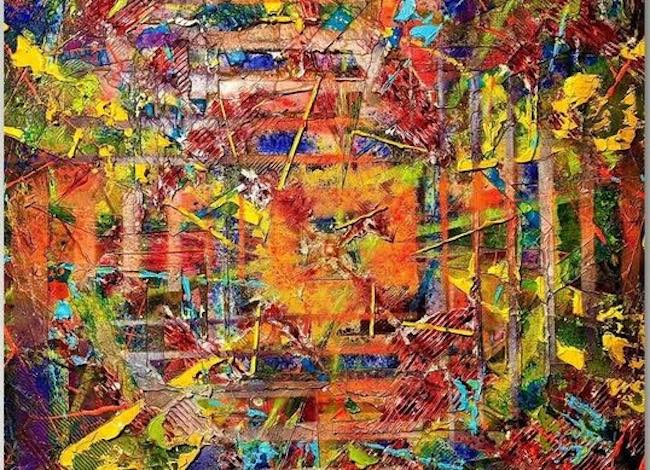La realtà contemporanea è talmente complessa e sfaccettata da rendere impossibile ad alcuni artisti riuscire a interpretarla senza immergersi esattamente in quella poliedricità e soggettività emergenti dall’attenta osservazione che solo i creativi, in virtù della loro particolare sensibilità, riescono a compiere; il linguaggio pittorico deve necessariamente conformarsi all’indole e alla natura espressiva di ciascun autore di un’opera, dunque la scelta dello stile dipende dalla capacità di riuscire a trasmettere con maggiore razionalità, o con maggiore o minore necessità di restare legati all’osservato. L’artista di cui vi racconterò oggi, pur scegliendo l’approccio informale è capace di reinterpretarlo e ridisegnarlo introducendo una ricerca che lo conduce a scegliere la materia, costituita dagli strati pittorici di cui sono contraddistinte le sue tele, e di studiare l’effetto risultante dei mezzi e dei materiali attraverso cui si esprime e plasma le opere.
Nel momento in cui la soggettività cominciò a voler far sentire la propria voce e gli artisti aderenti al movimento informale decisero di non voler più rinunciare a imprimere nelle opere le loro emozioni, uniche a creare nell’osservatore quel coinvolgimento inconscio che di fatto era una delle funzioni principali dell’arte, nacque negli Stati Uniti un movimento i cui fondatori intendevano ribellarsi al concetto precedente secondo cui il gesto plastico doveva mantenere la sua purezza e non doveva essere contaminato con le sensazioni dell’esecutore dell’opera. Quella nuova corrente artistica prese il nome di Espressionismo Astratto ed era destinata a rivoluzionare completamente tutte le basi dell’Arte Astratta, soprattutto quelle più rigide e schematiche del De Stijl, del Suprematismo e dell’Astrattismo Geometrico che tanto avevano dominato nei primi decenni del Ventesimo secolo. Anche in Europa, il gesto impulsivo e liberatorio dell’Action Painting affascinò molti giovani artisti che non trovavano pieno appagamento nei precedenti stili informali. L’atto fisico del Dripping, che contraddistinse le opere di Jackson Pollock, era di fatto una sperimentazione pittorica legata solo ed esclusivamente all’uso del colore, al rapporto intimo e totalmente irrazionale che apparteneva all’esecutore dell’opera e che si trasformava così in un’espressione a volte irruenta del sé; di contro gli artisti che avevano un’indole più tranquilla e riflessiva, optarono per il Color Field, più silenzioso eppure in grado di andare a far vibrare le corde più profonde dell’osservatore. In entrambi i casi il gesto plastico del creare arte diveniva il nuovo elemento della pittura. Laddove oltreoceano gli appartenenti all’Espressionismo Astratto rimanevano legati alla bidimensionalità dell’opera e alla variazione sull’utilizzo del colore, in Europa, e in particolar modo in Italia, l’Arte Informale modificò la sua essenza cominciando a inserire nella tela elementi materici, come nel caso del francese Jean Fautrier, che fu pioniere dell’Informale Materico e anticipatore delle sperimentazioni di Alberto Burri e di Antoni Tapìes che non solo utilizzarono materiali inediti, non convenzionali e spesso appartenenti alla produzione industriale o alla vita quotidiana bensì andarono oltre spingendosi ad agire sulle opere con la fiamma creando buchi che svelavano cosa si nascondesse oltre, oppure utilizzando la sovrapposizione di strati di materia diversa per cercare il contatto con la terza dimensione e comunicare in maniera più concreta con l’ossevatore. Dunque azione ed esplosione di emozioni nell’Espressionismo Astratto e utilizzo di materiali e sperimentazione artistica quasi scientifica nell’Informale Materico. L’artista ceco Tomáš Bittner sembra fondere queste due esperienze artistiche del Novecento e le armonizza con il suo desiderio di lasciar parlare i colori in modo spontaneo e irrazionale, producendo però opere dove i numerosi strati cromatici vanno a formare uno spessore a lui necessario per lasciar affiorare alla coscienza le emozioni più profonde, le riflessioni compiute in solitudine, e soprattutto per mescolare vari mezzi attraverso cui riesce a raggiungere sorprendenti risultati visivi; la sua arte tende infatti verso un approccio quasi psichedelico, nel senso letterale del termine poiché utilizza fosforo, inchiostri alcolici e spray all’acetone che cambiano aspetto e tonalità all’opera sulla base della luce di osservazione.

Dunque la magia dei colori e le sovrapposizioni appaiono evidenti quando si guardano le tele alla luce del giorno, se invece si osservano al buio si rivela la parte fluorescente, quella in cui le tonalità predominanti sono più fredde, e infine se si osservano in presenza dei raggi infrarossi escono in maniera predominante le tonalità luminescenti.
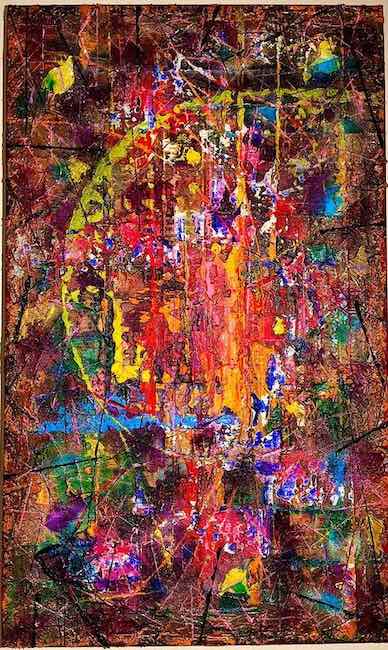
Eppure, nonostante l’inclinazione sperimentale e quasi scientifica all’utilizzo dei materiali, ciò che emerge in maniera chiara è la riflessione profonda che Tomáš Bittner compie nei confronti delle emozioni e delle tematiche che di volta in volta affronta nelle sue tele e che rappresentano l’attenta osservazione nei confronti di una realtà contemporanea troppo spesso tendente a restare in superficie, incapace di andare a esplorare tutto quel sottobosco di motivi e di ragioni che richiedono uno sforzo di introspezione verso cui l’uomo contemporaneo preferisce non avventurarsi.
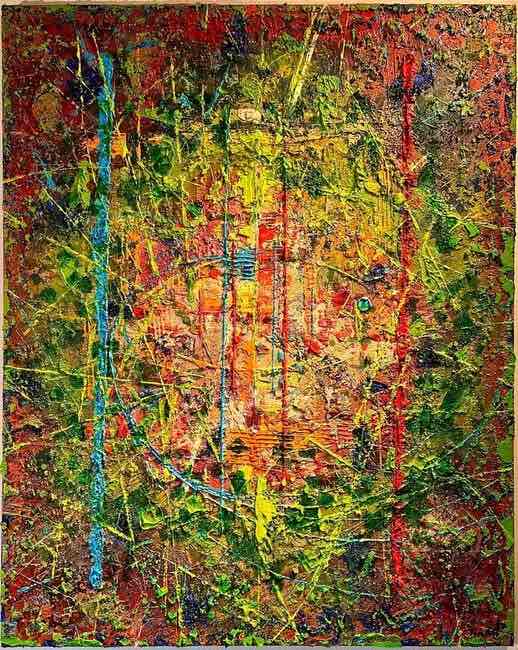
Tomáš Bittner al contrario lo affronta, lo porta alla luce e sottolinea quell’impegno esplorativo proprio attraverso gli strati pittorici sovrapposti; ogni tela è infatti costituita da un minimo di sei a un massimo di nove livelli e il risultato è incredibilmente magnetico e impattante sull’interiorità dell’osservatore che non può fare a meno di sentirsi attratto da quelle macchie di colore tridimensionali.
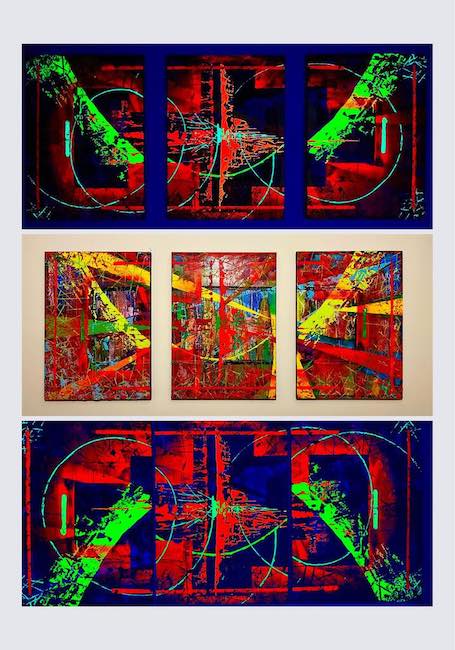
All’interno si trova il senso del titolo, come se l’artista volesse catalizzare l’attenzione verso la propria interpretazione lasciando tuttavia la facoltà a chi guarda di darne una diversa sulla base della sensibilità personale e anche della predisposizione a lasciarsi affascinare dalle tonalità più calde o da quelle più fredde; ma la semplice tridimensionalità non è sufficiente per spiegare e riprodurre le infinitesimali sfaccettature della realtà e così Bittner mostra quante altre opzioni esistano cambiando il punto di vista, di cui i materiali fluorescenti utilizzati divengono metafora, lasciandosi così l’opportunità di scoprire sfumature e di notare dettagli che diversamente non sarebbe possibile notare.
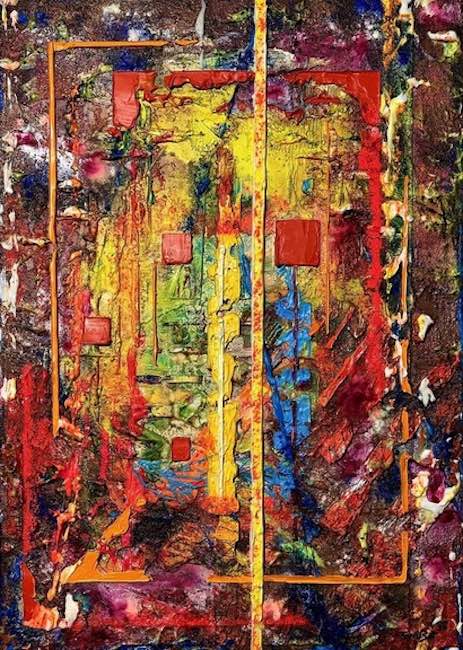
Nella tela Stability of Faith (Stabilità della Fede) l’artista costruisce una base cromatica intensa e decisa, per riprodurre le molte emozioni che si legano alla spiritualità, e poi, negli ultimi strati sembra voler costruire una struttura quasi geometrica, a riprodurre appunto la solidità, la saldezza di un’individuo che è capace di mantenersi legato ai valori più importanti, quelli più alti che rassicurano e al tempo stesso costituiscono una guida, una demarcazione tra ciò che è giusto e ciò che è sbagliato, tra ciò che appartiene al bene, malgrado gli errori in cui si può incorrere, e ciò che invece appartiene al male. La linea verticale al centro è esattamente una separazione, mentre ai suoi lati Tomáš Bittner mette altri punti saldi che possono costituire i princìpi a cui appigliarsi in caso di caduta, o sul lato opposto gli ostacoli che inevitabilmente si incontreranno nel momento in cui si sceglie di non farsi guidare dalla spiritualità.
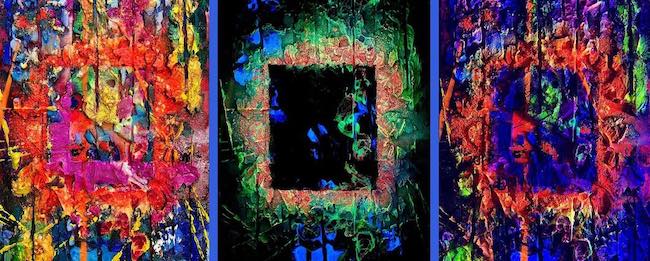
In Our own opinion is our light (La nostra opinione è la nostra luce) viene evidenziata la necessità di essere fedeli a se stessi, di non avere timore di manifestare le proprie idee e di pensare con la propria testa, anche se significa andare contro corrente e contro il pensiero comune, perché ciò che conta è non perdere la propria profonda identità, l’unica alla quale fare riferimento in momenti disorientanti. Qui il riquadro centrale sembra calamitare l’attenzione verso quell’essenziale, quella finestra di riferimento all’interno della quale tutto ciò che può accadere fuori non entra perché l’essere umano può scegliere di non farsi condizionare e di rimanere solidamente in piedi anche quando tutto intorno sembra crollare o generare confusione. Nell’immagine sono visibili i tre aspetti dell’opera: vista alla luce del giorno con le tonalità accese e vivaci in primo piano, poi nella versione notturna da cui emerge il nero del centro del riquadro che non rappresenta l’oscurità piuttosto sottolinea la suggestione generata dal silenzio di cui ha bisogno l’interiorità per ascoltare se stessa, e infine la visione attraverso il filtro dei raggi infrarossi, da cui emergono le tinte fluo, quell’aspetto variopinto e luminoso delle convinzioni più profonde e radicate, delle idee più appartenenti all’individuo.
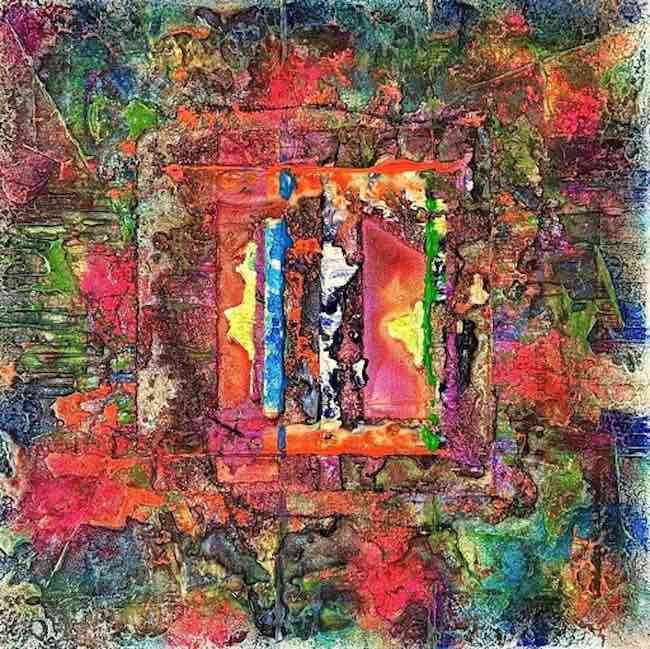
Tomáš Bittner specializzato in falegnameria artistica, si è occupato a lungo di lavori su legno e successivamente della realizzazione di marionette, poi però il richiamo dell’arte e un senso di mancata realizzazione lo hanno spinto nel 2020 ad abbandonare le precedenti esperienze e dedicarsi esclusivamente all’arte con ottimi risultati; ha al suo attivo la partecipazioni a saloni d’arte, fiere e mostre a Belgrado, Atene, Praga e a dicembre 2024 farà parte degli artisti di Noel en Art 2024 a Parigi.
TOMÀŠ BITTNER-CONTATTI
Email: artisttombitt@gmail.com
Sito web: www.originalgallery.com/it/lavori/tomas-bittner-ohnuty-v-case
Facebook: www.facebook.com/tombittart
Instagram: www.instagram.com/tombittart/
The pictorial overlaps of Tomáš Bittner, when Abstract Expressionism shows its most experimental and luminous side
Contemporary reality is so complex and multifaceted that it is impossible for some artists to succeed in interpreting it without immersing themselves precisely in that multifacetedness and subjectivity emerging from careful observation that only creatives, by virtue of their particular sensitivity, are able to perform; the pictorial language must necessarily conform to the character and expressive nature of each author of an artwork, so the choice of style depends on the ability to succeed in conveying the observed with greater rationality, or with greater or lesser need to remain attached to the observed. The artist I am going to tell you about today, although he chooses the informal approach, is capable of reinterpreting and redesigning it by introducing a research that leads him to choose the material, constituted by the pictorial layers with which his canvases are marked, and to study the resulting effect of the means and materials through which he expresses himself and shapes his artworks.
At a time when subjectivity began to want to make its voice heard and the artists adhering to the informal movement decided that they no longer wanted to renounce imprinting their emotions in their works, unique in creating in the observer that unconscious involvement that was in fact one of the main functions of art, was born in the United States a movement whose founders intended to rebel against the previous concept according to which the plastic gesture had to maintain its purity and should not be contaminated with the feelings of the artwork’s executor. That new artistic current took the name of Abstract Expressionism and was destined to completely revolutionise all the foundations of Abstract Art, especially the more rigid and schematic ones of De Stijl, Suprematism and Geometric Abstractionism that had so dominated the first decades of the 20th century. In Europe too, the impulsive and liberating gesture of Action Painting fascinated many young artists who had not found full fulfilment in the previous informal styles. The physical act of dripping, which distinguished the works of Jackson Pollock, was in fact a pictorial experimentation linked solely and exclusively to the use of colour, to the intimate and totally irrational relationship that belonged to the author and that was thus transformed into a sometimes impetuous expression of the self; on the other hand, artists with a quieter, more reflective nature opted for the more silent Colour Field, yet capable of striking the observer’s deepest chords. In both cases, the plastic gesture of creating art became the new element of painting. Where across the Atlantic the members of Abstract Expressionism remained tied to the two-dimensionality of the artwork and the variation in the use of colour, in Europe, and especially in Italy, Informal Art changed its essence by beginning to insert material elements into the canvas, as in the case of the Frenchman Jean Fautrier, who was a pioneer of the Materic Informal and a forerunner of the experiments of Alberto Burri and Antoni Tapìes, who not only used unusual materials, unconventional and often belonging to industrial production or everyday life, but went further by going so far as to act on the artworks with flames, creating holes that revealed what was hidden beyond, or by using overlapping layers of different materials to seek contact with the third dimension and communicate more concretely with the observer. So action and explosion of emotions in Abstract Expressionism and use of materials and almost scientific artistic experimentation in Materic Informal. The Czech artist Tomáš Bittner seems to merge these two artistic experiences of the 20th century and harmonises them with his desire to let colours speak spontaneously and irrationally, producing artaworks in which the numerous chromatic layers form a depth that he needs to let his deepest emotions and solitary reflections come to the surface of his consciousness, and above all to mix various media through which he achieves surprising visual results; in fact, his art tends towards an almost psychedelic approach, in the literal sense of the term, as he uses phosphorous, alcoholic inks and acetone sprays that change the appearance and tone of the artwork on the basis of the light of observation. Thus, the magic of colours and superimpositions are evident when one looks at the canvases in daylight, if, on the other hand, they are observed in the dark, the fluorescent part is revealed, where the predominant tones are cooler, and finally, if they are observed in the presence of infrared rays, the luminescent tones come out predominantly. And yet, despite the experimental and almost scientific inclination in the use of materials, what clearly emerges is Tomáš Bittner‘s profound reflection on the emotions and themes that he deals with in his canvases and which represent the careful observation of a contemporary reality that all too often tends to remain on the surface, incapable of exploring all that undergrowth of motives and reasons that require an effort of introspection towards which contemporary man prefers not to venture. Tomáš Bittner, on the contrary, confronts it, brings it to light and emphasises that exploratory effort precisely through the overlapping pictorial layers; each canvas consists of a minimum of six to a maximum of nine levels, and the result is incredibly magnetic and impactful on the interiority of the observer who cannot help but feel drawn to those three-dimensional patches of colour. Inside is the meaning of the title, as if the artist wanted to catalyse attention towards his own interpretation, leaving the viewer free to give a different one on the basis of personal sensitivity and also of the predisposition to be fascinated by warmer or cooler tones; but simple three-dimensionality is not enough to explain and reproduce the infinitesimal facets of reality, and so Bittner shows how many other options exist by changing the point of view, of which the fluorescent materials used become a metaphor, thus allowing the opportunity to discover nuances and notice details that otherwise would not be possible. In the canvas Stability of Faith, the artist builds an intense and decisive chromatic base, to reproduce the many emotions that are linked to spirituality, and then, in the last layers, seems to want to build an almost geometric structure, to reproduce precisely the solidity, the steadfastness of an individual who is able to hold on to the most important values, the highest ones that reassure and at the same time constitute a guide, a demarcation between what is right and what is wrong, between what belongs to the good, despite the mistakes one may make, and what belongs to evil. The vertical line in the centre is precisely a separation, while on its sides Tomáš Bittner places other firm points that can be the principles to hold on to in the event of a fall, or on the opposite side the obstacles that will inevitably be encountered when one chooses not to be guided by spirituality. In Our own opinion is our light, is highlighted the need to be true to oneself, to not be afraid to express one’s ideas and to think for oneself, even if it means going against the current and against common thought, because what counts is not to lose one’s own profound identity, the only one to which one can refer in disorienting moments. Here the central frame seems to draw attention to that essential, that window of reference within which everything that may happen outside does not enter because the human being can choose not to be conditioned and to remain solidly on his feet even when everything around him seems to be collapsing or generating confusion. In the image are visible the three aspects of the artwork: seen in daylight with the bright and vivid hues in the foreground, then in the night version from which emerges the blackness of the centre of the frame that does not represent darkness but rather emphasises the suggestion generated by the silence that inner life needs to listen to itself, and finally the vision through the infrared filter, from which emerge the fluorescent hues, that multicoloured and luminous aspect of the deepest and most rooted convictions, of the ideas that belong most to the individual. Tomáš Bittner specialised in artistic carpentry, for a long time he was involved in woodwork and later in the creation of puppets, but then the call of art and a sense of unfulfillment prompted him in 2020 to abandon his previous experiences and devote himself exclusively to art with excellent results; he has to his credit the participation in art salons, fairs and exhibitions in Belgrade, Athens, Prague and in December 2024 he will be one of the artists at Noel en Art 2024 in Paris.


